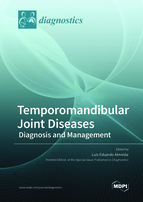Temporomandibular Joint Diseases: Diagnosis and Management
A special issue of Diagnostics (ISSN 2075-4418). This special issue belongs to the section "Pathology and Molecular Diagnostics".
Deadline for manuscript submissions: closed (31 January 2022) | Viewed by 49260
Special Issue Editor
Interests: temporomandibular joint; immunohistochemistry; inflammation
Special Issues, Collections and Topics in MDPI journals
Special Issue Information
The temporomandibular joint (TMJ) is capable of remodeling even after growth has stopped, allowing it to make structural changes and adapt to different physiological demands.
Temporomandibular disorders (TMD) are a group of degenerative disorders involving the components of the TMJ, which can lead to displacement of the disc, joint remodeling, and eventually osteoarthritis.
Different methods of diagnosis and treatments of TMD have been described in the literature in the past years.
The aim of this Special Edition is to bring updated information regarding all methods of diagnosis of TMD, from clinical exams to immunohistologic and molecular diagnosis and novel treatments for this disease, ranging from non-invasive techniques, such as physical therapy, ultrasound, low-level laser therapy, and splints, to minimally invasive techniques, such as corticosteroid injections, arthrocentesis of the joint, with or without platelet-rich plasma or hyaluronic acid injections, and arthroscopic surgery, to invasive procedures for the more advanced stage of TMD, which include discectomy, disc replacement, and total joint replacement.
Prof. Dr. Luis Eduardo Almeida
Guest Editor
Manuscript Submission Information
Manuscripts should be submitted online at www.mdpi.com by registering and logging in to this website. Once you are registered, click here to go to the submission form. Manuscripts can be submitted until the deadline. All submissions that pass pre-check are peer-reviewed. Accepted papers will be published continuously in the journal (as soon as accepted) and will be listed together on the special issue website. Research articles, review articles as well as short communications are invited. For planned papers, a title and short abstract (about 100 words) can be sent to the Editorial Office for announcement on this website.
Submitted manuscripts should not have been published previously, nor be under consideration for publication elsewhere (except conference proceedings papers). All manuscripts are thoroughly refereed through a single-blind peer-review process. A guide for authors and other relevant information for submission of manuscripts is available on the Instructions for Authors page. Diagnostics is an international peer-reviewed open access semimonthly journal published by MDPI.
Please visit the Instructions for Authors page before submitting a manuscript. The Article Processing Charge (APC) for publication in this open access journal is 2600 CHF (Swiss Francs). Submitted papers should be well formatted and use good English. Authors may use MDPI's English editing service prior to publication or during author revisions.
Keywords
- Temporomandibular joint
- Temporomandibular disease
- Inflammation
- Occlusion







